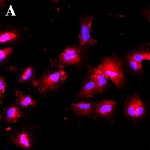Mechanical stretch: physiological and pathological implications for human vascular endothelial cells
Main Article Content
Abstract
Vascular endothelial cells are subjected to hemodynamic forces such as mechanical stretch due to the pulsatile nature of blood flow. Mechanical stretch of different intensities is detected by mechanoreceptors on the cell surface which enables the conversion of external mechanical stimuli to biochemical signals in the cell, activating downstream signaling pathways. This activation may vary depending on whether the cell is exposed to physiological or pathological stretch intensities. Substantial stretch associated with normal physiological functioning is important in maintaining vascular homeostasis as it is involved in the regulation of cell structure, vascular angiogenesis, proliferation and control of vascular tone. However, the elevated pressure that occurs with hypertension exposes cells to excessive mechanical load, and this may lead to pathological consequences through the formation of reactive oxygen species, inflammation and/or apoptosis. These processes are activated by downstream signaling through various pathways that determine the fate of cells. Identification of the proteins involved in these processes may help elucidate novel mechanisms involved in vascular disease associated with pathological mechanical stretch and could provide new insight into therapeutic strategies aimed at countering the mechanisms’ negative effects.
Article Details
How to Cite
JUFRI, Nurul F. et al.
Mechanical stretch: physiological and pathological implications for human vascular endothelial cells.
Vascular Cell, [S.l.], v. 7, n. 1, p. 8, sep. 2015.
ISSN 2045-824X.
Available at: <https://vascularcell.com/index.php/vc/article/view/10.1186-s13221-015-0033-z>. Date accessed: 19 apr. 2024.
doi: http://dx.doi.org/10.1186/s13221-015-0033-z.
Section
Review

